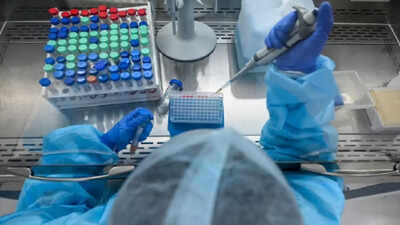Top Searches
- News
- City News
- mumbai News
- Maharashtra’s weekly Covid positivity rate rises to 1%, but no spike in hospital admissions
Maharashtra’s weekly Covid positivity rate rises to 1%, but no spike in hospital admissions

Photo for representative purpose only
MUMBAI/PUNE: Maharashtra’s weekly positivity rate (WPR), considered a robust marker to track growth in Covid-19 cases, has steadily inched upwards to touch 1% recently after hovering between 0.4% to 0.7% throughout April. It indicates that the virus is circulating in the community, although a positivity rate above 5% is considered more concerning.
The good news though is that the rise in viral activity has not translated into more hospitalisations or Covid-19 deaths. In fact, out of the 1,400-odd active cases in the state, just 3.3% are currently admitted to hospitals. Of the 45 hospitalised cases, 10 are serious. It has been more than a month that the mask mandate and most other Covid-related restrictions were removed in Maharashtra. Experts said it doesn’t appear to have caused any worrying spurt so far.
State surveillance officer Dr Pradeep Awate told TOI on Thursday that trends show the Covid situation is still “very much in control” in Maharashtra. “There hasn’t been an alarming rise in cases over the last three to four weeks. Nearly 90% of all new patients are asymptomatic and we’re not seeing an increase in hospitalisations,” he added. The average daily detections are in the range of 200-250 in May, up from the April average of 130.
According to Dr Awate, the recent spikes in Covid cases may have been due to factors like higher mobility in the population, changes in immunity levels and seasonal changes. Despite the increase in Covid cases, Maharashtra’s active caseload per million residents is still at 11, lower than India’s average of 14 and significantly less than what’s being reported from states such as Delhi, Karnataka, Kerala and Haryana. Delhi, for instance, has reported 320 active Covid cases per million population. All these data sets, Dr Awate added, indicate another Covid wave is unlikely unless one is triggered by a completely new variant.
Epidemiologist Dr Jayaprakash Muliyil told TOI that the rise in cases is due to minor fluctuations that are expected to be seen every now and then from pockets of the population that have not been exposed to Omicron. Dr Awate said that this fluctuation in caseload was akin to the waning days of the swine flu outbreak.
Interestingly, the majority of the cases are now concentrated only in five districts—Mumbai, Pune, Thane, Raigad and Ahmednagar. At least 20 districts have active cases in single digits while 10 districts have zero patients under treatment. In Mumbai, for instance, 22 patients are hospitalised, occupying 0.09% of beds.
Dr Shashank Joshi, a member of the state Covid-19 taskforce, said it is strongly advisable to wear a mask in indoor settings for protection. “We shouldn’t take our eyes off genome sequencing even if cases are this low,” he said. A state official said senior citizens should take booster shots. Recent state data showed that less than 35% of people above 60 years have taken the precautionary dose.
The good news though is that the rise in viral activity has not translated into more hospitalisations or Covid-19 deaths. In fact, out of the 1,400-odd active cases in the state, just 3.3% are currently admitted to hospitals. Of the 45 hospitalised cases, 10 are serious. It has been more than a month that the mask mandate and most other Covid-related restrictions were removed in Maharashtra. Experts said it doesn’t appear to have caused any worrying spurt so far.
State surveillance officer Dr Pradeep Awate told TOI on Thursday that trends show the Covid situation is still “very much in control” in Maharashtra. “There hasn’t been an alarming rise in cases over the last three to four weeks. Nearly 90% of all new patients are asymptomatic and we’re not seeing an increase in hospitalisations,” he added. The average daily detections are in the range of 200-250 in May, up from the April average of 130.
According to Dr Awate, the recent spikes in Covid cases may have been due to factors like higher mobility in the population, changes in immunity levels and seasonal changes. Despite the increase in Covid cases, Maharashtra’s active caseload per million residents is still at 11, lower than India’s average of 14 and significantly less than what’s being reported from states such as Delhi, Karnataka, Kerala and Haryana. Delhi, for instance, has reported 320 active Covid cases per million population. All these data sets, Dr Awate added, indicate another Covid wave is unlikely unless one is triggered by a completely new variant.
Epidemiologist Dr Jayaprakash Muliyil told TOI that the rise in cases is due to minor fluctuations that are expected to be seen every now and then from pockets of the population that have not been exposed to Omicron. Dr Awate said that this fluctuation in caseload was akin to the waning days of the swine flu outbreak.
Interestingly, the majority of the cases are now concentrated only in five districts—Mumbai, Pune, Thane, Raigad and Ahmednagar. At least 20 districts have active cases in single digits while 10 districts have zero patients under treatment. In Mumbai, for instance, 22 patients are hospitalised, occupying 0.09% of beds.
Dr Shashank Joshi, a member of the state Covid-19 taskforce, said it is strongly advisable to wear a mask in indoor settings for protection. “We shouldn’t take our eyes off genome sequencing even if cases are this low,” he said. A state official said senior citizens should take booster shots. Recent state data showed that less than 35% of people above 60 years have taken the precautionary dose.
FOLLOW US ON SOCIAL MEDIA
FacebookTwitterInstagram
Looking for Something?

Start a Conversation
end of article

